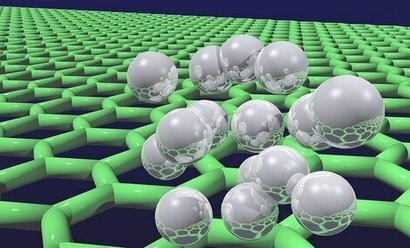
Sustainable electrolysis for green hydrogen production is challenging, primarily due to the absence of efficient, low-cost, and stable catalysts for the oxygen evolution reaction (OER) in acidic solutions. A team of researchers has now developed a ruthenium catalyst by doping it with zinc, resulting in enhanced stability and reactivity compared to its commercial version. The proposed strategy can revolutionise hydrogen production by paving the way for next generation electrocatalysts that contribute to clean energy technologies.
Electrolysis is a process that uses electricity to create hydrogen and oxygen molecules from water. The use of proton exchange membrane (PEM) and renewable energy for water electrolysis is widely regarded as a sustainable method for hydrogen production. However, a challenge in advancing PEM water electrolysis technology is the lack of efficient, low-cost, and stable catalysts for oxygen evolution reaction (OER) in acidic solutions during PEM water electrolysis.
While iridium-based catalysts are a potential solution, metallic iridium is rare and expensive in nature. Alternately, oxides of ruthenium (RuO2) offer a more affordable and reactive option, but they also suffer from stability issues. Therefore, researchers are exploring ways to improve the stability of the RuO2 structure to develop promising OER catalysts for the successful implementation of the hydrogen production technology.
Now, in a recent study made available online on 22 September 2023 and to be published in Volume 88 of the Journal of Energy Chemistry in January 2024, a group of researchers, led by Professor Haeseong Jang from the Department of Advanced Materials Engineering at Chung-Ang University in South Korea, has developed a promising OER catalyst. Denoted as SA Zn-RuO2, the catalyst comprises of RuO2 stabilised by single atoms of zinc.
“We were motivated by the need to find efficient and cost-effective alternative electrocatalysts for OER in PEM water electrolysis” said Professor Jang, elaborating about the study. “Based on our study, we propose a dual-engineering strategy, involving single atom Zn doping and the introduction of oxygen vacancies, to balance high catalytic activity with stability during acidic OER.”
The researchers synthesised SA Zn-RuO2 by heating an organic framework with ruthenium (Ru) and zinc atoms, forming a structure with oxygen vacancies (missing oxygen atoms that positively alter the properties) and Zn-O-Ru linkages. These linkages stabilise the catalyst in two ways - one, by strengthening the Ru-O bonds, and second, by providing electrons from zinc atoms to protect ruthenium from overoxidation during the OER process. Furthermore, the improved electronic environment around the ruthenium atoms lowers the energies needed for molecules to stick to the surface, thus lowering the energy barrier for the reaction.
The resulting catalyst was more stable, with no apparent fall in reactivity, and significantly outperformed commercial RuO2. Moreover, it required less extra energy (low overpotential of 213 mV compared to 270 mV for commercial RuO2) and remained functional for a longer period (43 hours compared to 7.4 hours for commercial RuO2).
Due to its improved stability and features, the newly proposed SA Zn-RuO2 catalyst has the potential to influence the development of cost-effective, active, and acid-resistant electrocatalysts for OER. This, in turn, could help in reducing costs and enhancing the production of green hydrogen, aiding in a shift toward cleaner energy sources and advancements in sustainable technologies.
“We believe that this shift can revolutionise industries, transportation, and energy infrastructure, and contribute to the efforts aimed at combating climate change and fostering a more resilient and environmentally conscious future” added Professor Jang. “This is because accessible green hydrogen can have a transformative impact on societies by mitigating environmental impacts, creating jobs, and ensuring energy security through diversified and sustainable energy solutions.”
In summary, the highly reactive and catalytically stable RuO2 catalyst for the acidic OER has increased durability and favorable characteristics, and holds immense potential for guiding the design of robust and active non-iridium-based OER electrocatalysts for practical applications.
For additional information:

